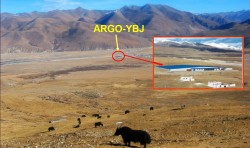 The study and the measurement of the Cosmic Rays are very interesting items in the Astroparticle Physics field. Despite the large progress reached in this field due to new detectors and analysis techniques, the key questions concerning origin, acceleration and propagation of Galactic Cosmic Rays are still open. Furthermore the Cosmic Rays sources are the most powerful particle accelerators. The ARGO-YBJ experiment has been designed to face these problems, it has been built at the YangBaJing Cosmic Ray Observatory (Tibet, P. R. China, 4300m a.s.l., 606 g/cm2). The ARGO-YBJ detector consists of a single layer of RPCs operated in streamer mode, housed in a large building of about 11,000 m2. The signals from each RPC are picked up by 80 readout strips 61.8 cm long and 6.75 cm wide (23 strips/m2) that allow the shower front reconstruction with a high space-time resolution. In order to fully investigate the PeV region, where the readout by strips saturates, an analog readout has been implemented by instrumenting each RPC with two large size electrodes of dimensions 1.23 × 1.39 m2. ARGO-YBJ has been in stable data taking for more than 5 years with a duty-cycle greater than 86%, the detector collected about 5 x 10^11 events in a wide energy range, from few hundred GeV up to about 10PeV. High altitude location and detector features make ARGO-YBJ capable of investigating a wide range of important issues in Cosmic Ray and Astroparticle Physics by imaging the front of atmospheric showers with unprecedented resolution and detail. The ARGO-YBJ group is completely devoted to the analysis of this huge amount of data, in particular to the study of the CR energy spectrum up to PeVs with an original technique based on a bayesian approach. This analysis allowed for the first time the observation of a knee-like structure in the light component (p +He) spectrum around 700TeV, it will be ended in the year 2016.
The study and the measurement of the Cosmic Rays are very interesting items in the Astroparticle Physics field. Despite the large progress reached in this field due to new detectors and analysis techniques, the key questions concerning origin, acceleration and propagation of Galactic Cosmic Rays are still open. Furthermore the Cosmic Rays sources are the most powerful particle accelerators. The ARGO-YBJ experiment has been designed to face these problems, it has been built at the YangBaJing Cosmic Ray Observatory (Tibet, P. R. China, 4300m a.s.l., 606 g/cm2). The ARGO-YBJ detector consists of a single layer of RPCs operated in streamer mode, housed in a large building of about 11,000 m2. The signals from each RPC are picked up by 80 readout strips 61.8 cm long and 6.75 cm wide (23 strips/m2) that allow the shower front reconstruction with a high space-time resolution. In order to fully investigate the PeV region, where the readout by strips saturates, an analog readout has been implemented by instrumenting each RPC with two large size electrodes of dimensions 1.23 × 1.39 m2. ARGO-YBJ has been in stable data taking for more than 5 years with a duty-cycle greater than 86%, the detector collected about 5 x 10^11 events in a wide energy range, from few hundred GeV up to about 10PeV. High altitude location and detector features make ARGO-YBJ capable of investigating a wide range of important issues in Cosmic Ray and Astroparticle Physics by imaging the front of atmospheric showers with unprecedented resolution and detail. The ARGO-YBJ group is completely devoted to the analysis of this huge amount of data, in particular to the study of the CR energy spectrum up to PeVs with an original technique based on a bayesian approach. This analysis allowed for the first time the observation of a knee-like structure in the light component (p +He) spectrum around 700TeV, it will be ended in the year 2016.
People involved in this experiment: S.M. Mari, P. Montini


